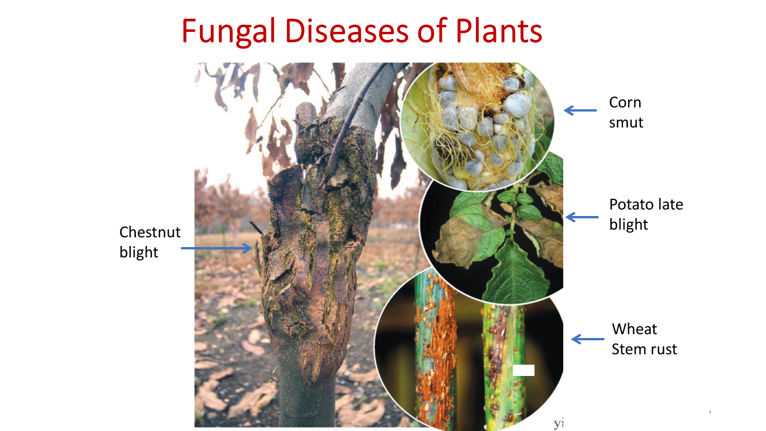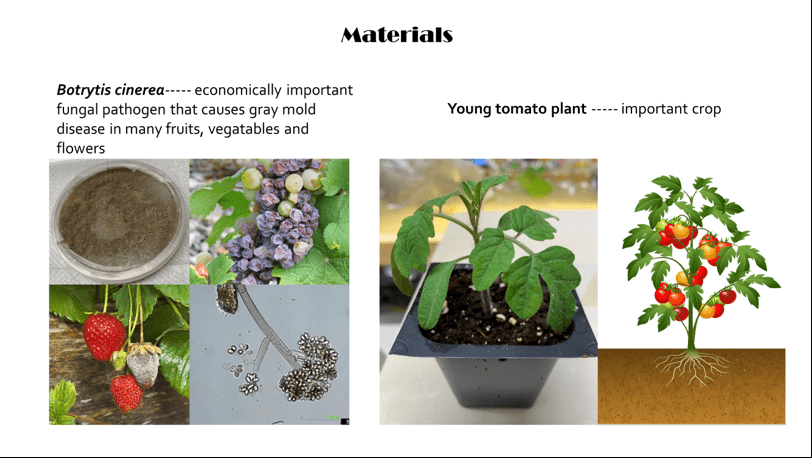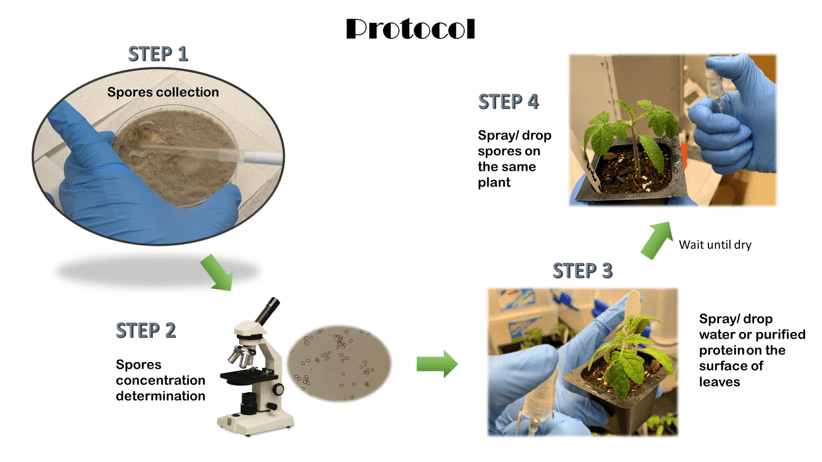How Plants Fight Back
Fungal diseases such as wheat head scab, wheat rusts, rice blast and sheath blight, soybean rust, banana black sigatoka are a major threat to food security and food safety. Some fungal pathogens produce mycotoxins that pose a major threat to human and animal health. Fungal diseases cause 12-15% yield loss in crops. The fungicide market will be a 17 billion industry by 2022. Fungal resistance to fungicides and environmental damage are major global challenges.

The goal of the “How Plants Fight Back” authentic research experience is: To develop spray-on peptide-based biofungicides for control of fungal diseases in crops.
Target age groups: This activity can be scaffolded to biology classrooms at the middle School, High School and undergraduate levels.
Research question/theme: Test the potential of antifungal plant defensins to control gray mold disease caused by Botrytis cinerea in tomato.
Student learning objectives from this activity:
Students will gain an understanding of fungal biology and be able to answer the following:
- How do fungal pathogens infect host plants?
- What is the disease cycle of a fungal pathogen (for example: Botrytis cinerea)
- How do plants fight back against fungal pathogens?
- How to grow fungi in vitro?
- How to purify antifungal peptides and determine their antifungal activity?
- Understand how scientists perform in-planta infection assays and record fungal infections under laboratory conditions
Method:
- Grow cinerea fungal pathogen in the laboratory.
- Purify recombinant defensin peptide using chromatographic techniques
- Inoculate tomato seedlings with cinerea fungal pathogen and apply plant defensins in planta (drop-inoculation or spray assay method).
- Incubate plants for ~ 48 hours
- Fungal disease scoring (lesion size) using an imaging device.
- Analyze images using Image J software for Antifungal activity of plant defensins against cinerea


Scientific Personnel:
 Dr. Dilip Shah is a Principal Investigator at the Donald Danforth Plant Science Center. His lab is involved in studying the interactions of fungal pathogens with their host plants and developing strategies for the development of disease resistant transgenic crops. The major focus of his lab is investigating the modes of action and biological roles of a group of plant defense proteins known as defensins and defensing-like peptides that inhibit the growth of a broad-spectrum of fungal pathogens and expressing these proteins in transgenic crops for control of economically important fungal pathogens. Dr. Shah has over 30 years of experience in plant-microbe interactions and agricultural biotechnology. He has made substantial contributions to the development of herbicide- and virus-resistant crops and led a team of scientists working on fungus-resistant crops during his previous tenure at Monsanto Company. He has published more than 90 peer-reviewed papers in various journals and is a co-inventor on a number of patents on the generation of disease- and herbicide-resistant crops. His patents on herbicide-resistant crops were listed as “Ten Patents That Changed the World” in 2003 year-end publication of Intellectual Property Worldwide.
Dr. Dilip Shah is a Principal Investigator at the Donald Danforth Plant Science Center. His lab is involved in studying the interactions of fungal pathogens with their host plants and developing strategies for the development of disease resistant transgenic crops. The major focus of his lab is investigating the modes of action and biological roles of a group of plant defense proteins known as defensins and defensing-like peptides that inhibit the growth of a broad-spectrum of fungal pathogens and expressing these proteins in transgenic crops for control of economically important fungal pathogens. Dr. Shah has over 30 years of experience in plant-microbe interactions and agricultural biotechnology. He has made substantial contributions to the development of herbicide- and virus-resistant crops and led a team of scientists working on fungus-resistant crops during his previous tenure at Monsanto Company. He has published more than 90 peer-reviewed papers in various journals and is a co-inventor on a number of patents on the generation of disease- and herbicide-resistant crops. His patents on herbicide-resistant crops were listed as “Ten Patents That Changed the World” in 2003 year-end publication of Intellectual Property Worldwide.
Postdoctoral Associates
Meenakshi Tetorya, PhD
Email contact: mtetorya@danforthcenter.org
Hui Li, PhD
Email contact: hli@danforthcenter.org
Djami Tchatchou, Arnaud Thierry, PhD
Email contact: ADjamiTchatchou@danforthcenter.org
Education Research and Outreach Team
Ruth Kaggwa, PhD
Education Researcher and Program Manager
Email contact: RKaggwa@danforthcenter.org
Kathryn M. Parsley, PhD
Education Project Manager
Email contact: KParsley@DanforthCenter.org
www.kathrynmparsley.com
@KathrynMParlsey
Please contact RKaggwa@danforthcenter.org or KParsley@DanforthCenter.org to learn more about taking this activity to your classroom.